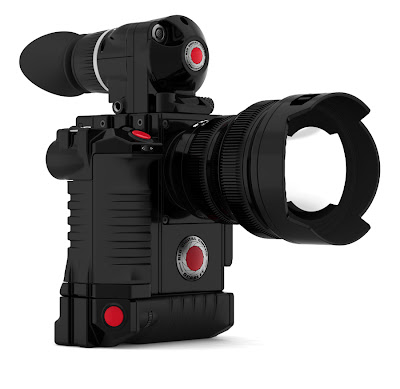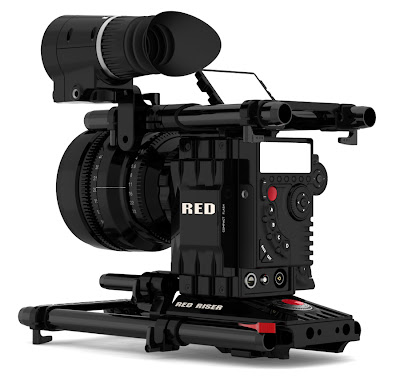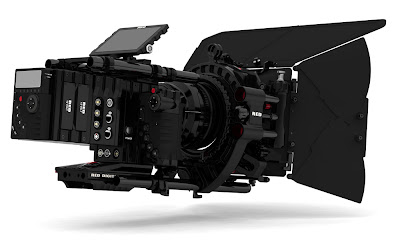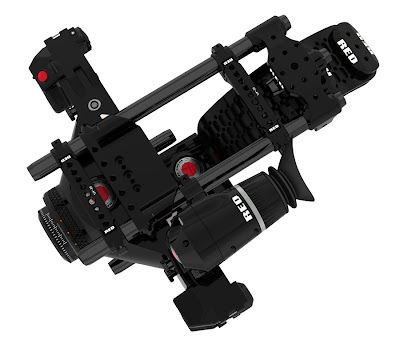
I was excited about the RED announcements, and they did not disappoint. Watching Jim trickle in his grand vision to the teeming throngs of online fans was good giddy fun and masterful PR. I watch Jobs keynotes the same way, but not with such a close-knit group of online friends. The brilliant Jim Jannard saved himself the expense of the Moscone Center, instead creating the world’s biggest virtual film-nerd sleepover for the mere cost of some extra server bandwidth.
With the usual caveats that their announced specs often change, RED also did not disappoint there—because they announced every spec anyone ever imagined and more. It’s the Forest Gump of technology unveilings—everyone sees what they want, and therefore believes it was made just for them. The renderings are very pretty, and anyone from a fan of the original Scarlet design to a stereo IMAX ride film producer can see their needs borne out in shiny black ray tracings.
And that’s the idea, of course—that anyone should be able to assemble their perfect camera for their needs from Jim’s bag of building blocks.
But I’m afraid that I’m not seeing my perfect camera among the options.
I’ve mentioned before that what I like about RED One’s 4K resolution is that it makes a very nice 2K image. I don’t think films benefit much from 4K, and for my own filmmaking there are a hundred places I’d rather put my time, money and energy than into more pixel count than most audience members can perceive under the best of conditions. But a rock-solid 2K image requires some downsampling from a bayer-pattern sensor. The sweet spot for great-looking 2K RGB is between 3–4K bayer origination.
So 4K is the cap on my resolution interest. But as far as sensor size goes, I do quite like the choices offered, especially right in the middle of the lineup. A cinema-sized Super35 chip is nice (RED’s S35 size), and a full-frame DSLR (or VistaVision for movie folks) sensor is kinda cool too (RED calls this FF35). Both would work very well with lenses I already have, which was one of my hopes.
But the least expensive RED “brain” with a cinema sensor is the Scarlet S35, and it’s $7,000. That’s without LCD, buttons, or lens. Although it’s the cheapset option with a big chip, it shoots 5K, which is way more resolution than I care about.
The Scarlet FF35, which has a sensor the same size as the Canon 5D and 5D MarkII, is $12,000 for just the brain. It shoots 6K, adding more overhead to my workflow that won’t wind up on the screen.
Worse still, these boxes only overcrank up to 30 fps, whereas the $2,500 2/3” Scarlet can run up to 120 fps at a very usable 3K.
If you want more frames-per-second for slow motion, you have to go to Epic, where a S35 sensor costs you $28,000 and a FF35 sensor is $35,000. For that you get 5K and 6K respectively and up to 100 fps. Still not as much overcrank as the cheapest brain with the most sensible resolution, and a ton of dough for an unwieldy data rate.
I look at these options and I feel like I’m paying for pixels, when I’d much rather be paying for dynamic range, frame rate, and sensor size. For a stills camera, these 5K and up resolutions make sense. But for filmmaking (and I’m talking professional filmmaking, not DV Rebel—this is not a DV Rebel camera discussion here!) it’s just not of any real value to me. More pixels means less dynamic range. More pixels means more data being pushed around that doesn’t make my movie better. More pixels means more compression to meet the low data rates of the less expensive brains.
The brain I’d be excited about would be a S35 or FF35 sensor at 3K, with up to 120fps. The pixels would be huge, the dynamic range would be great, and the 3K bayer would downsample to a lovely 2K image, which would be more than sharp enough to show me that I’d miss-focussed, or that my lead actress had an unfortunate allergy to her makeup.
If you absolutely had to make this thing 4K that would be OK, but not if that limited me to 100 fps, and not if it increased the price.
Remember that RED’s raw recording methodology means that you can’t decouple the Redcode Raw recordings from the native sensor resolution. If you buy a 5K brain, you can’t shoot anything other than 5K unless you’re willing to window in on that big chip, eliminating the whole point of the cinema-sized sensor.
By aiming for a piece of the stills market, RED has encumbered the sweet spot of their movie-making product line with unnecessary pixel counts, sacrificing much more important things along the way.
 Wednesday, December 15, 2010 at 12:22AM
Wednesday, December 15, 2010 at 12:22AM 















